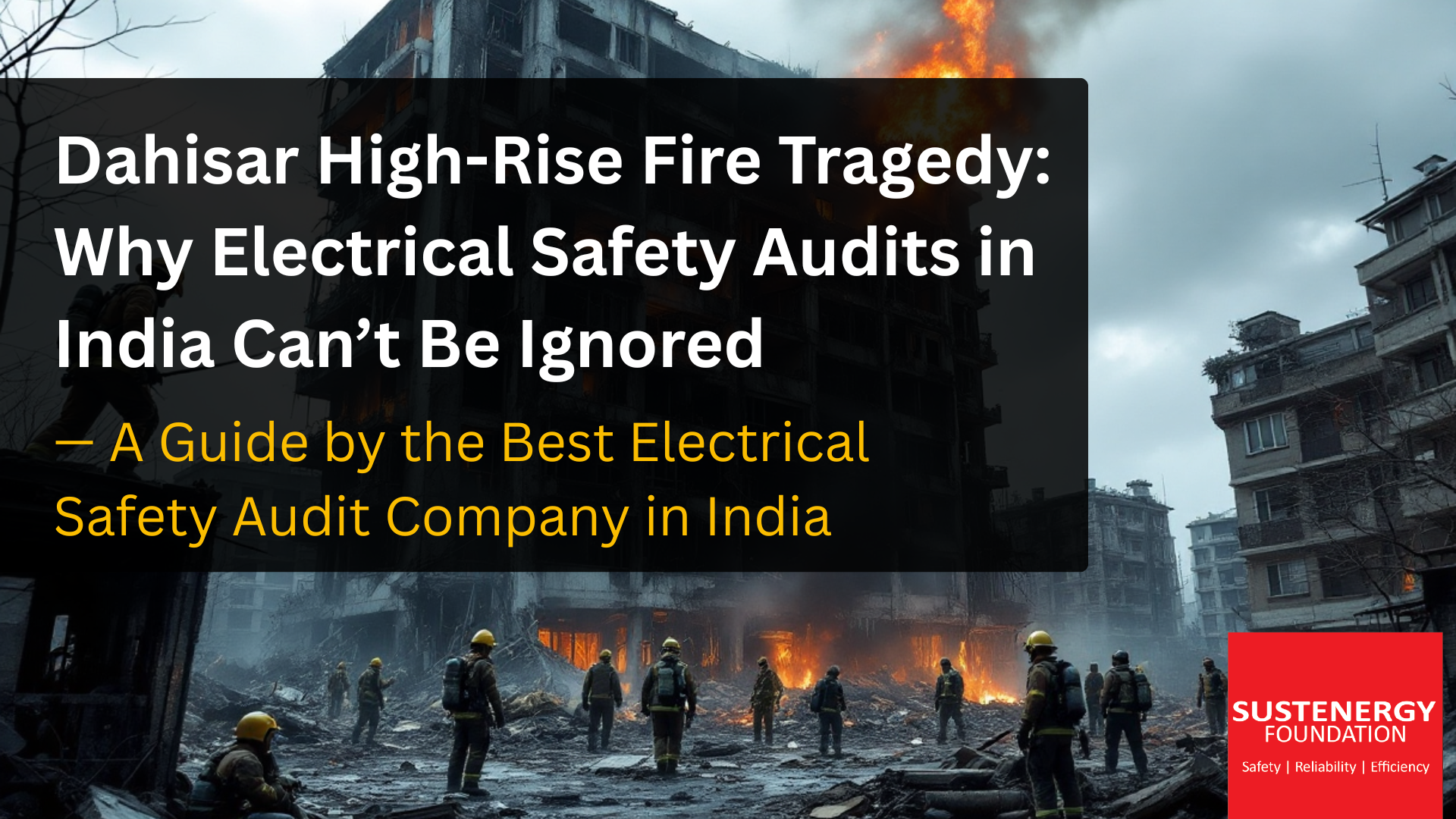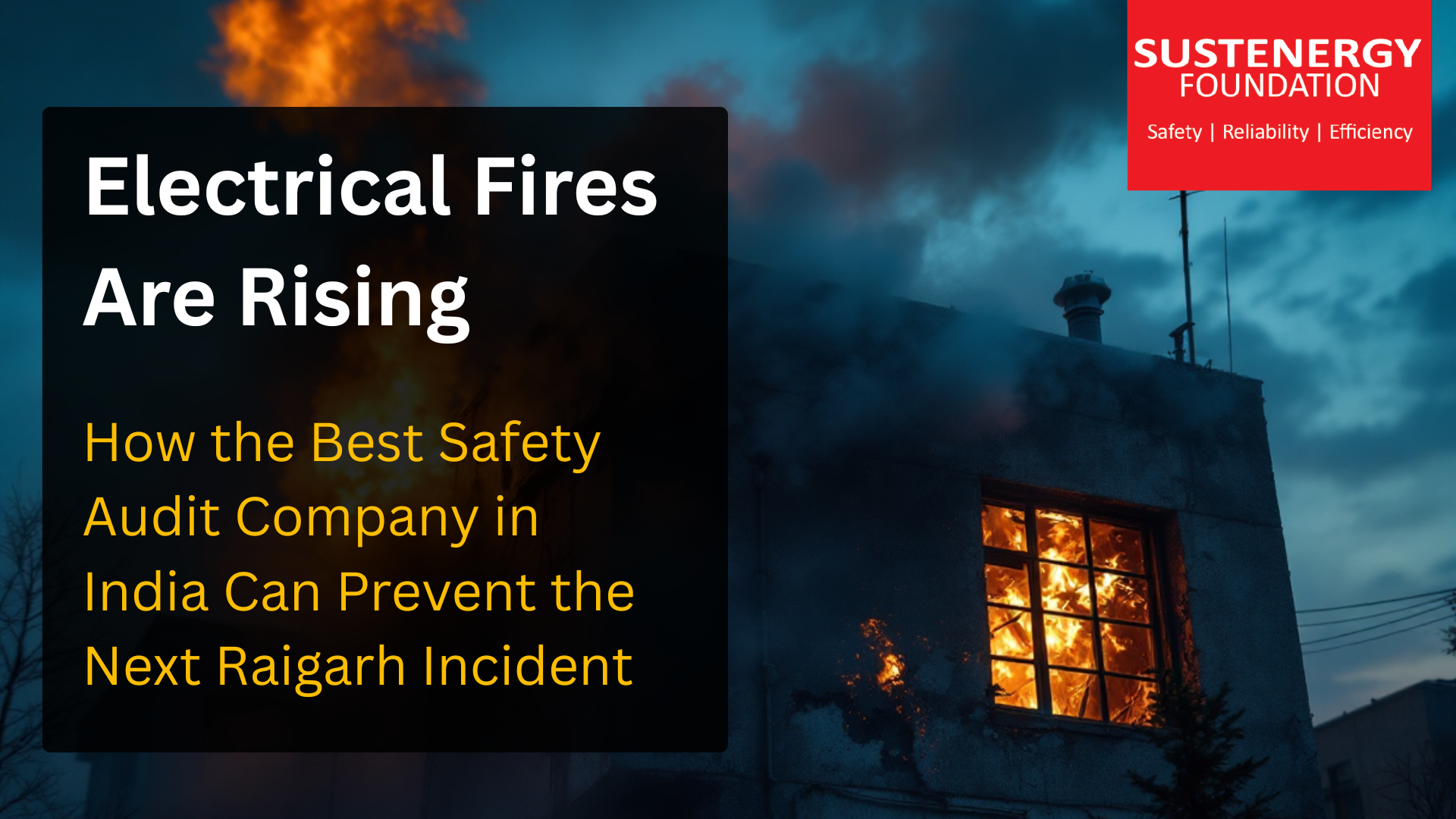
Dahisar High-Rise Fire Tragedy: Why Electrical Safety Audits in India Can’t Be Ignored
On September 7, 2025, a deadly fire broke out in the New Janakalyan Society, a 23-storey Slum Rehabilitation Authority (SRA) building in Dahisar East, Mumbai. This tragic incident, caused by a short circuit in the electric meter room, resulted in two deaths, 22 hospitalizations, and significant trauma for residents. The fire spread rapidly through open vertical electric ducts, worsened by overloaded and poorly maintained wiring, non-functional fire safety systems, and a lack of proper evacuation routes. The Dahisar fire highlights the urgent need for electrical safety audits in India, preventive inspections, and strict adherence to fire safety protocols in high-rise buildings.
This blog, prepared by Sustenergy Foundation, India’s leading Best Electrical Safety Audit Company in India, covers all key aspects of electrical safety, high-rise fire hazards, and the critical role of audits in preventing disasters. Here’s what you will learn:
- The details of the Dahisar High-Rise Fire
- Electrical failures and fire safety gaps
- The alarming statistics of electrical fires in Mumbai
- What an electrical safety audit entails
- Key components of a high-rise electrical safety audit
- Special considerations for SRA buildings
- Actionable recommendations for builders, residents, and authorities
- How Sustenergy Foundation’s energy audit services India and electrical safety expertise can prevent future tragedies
The Dahisar High-Rise Fire: What Happened
At around 3:00 p.m., smoke was noticed in the basement of the New Janakalyan Society. Within minutes, the fire spread vertically through the electric duct system, trapping residents on multiple floors. Families scrambled to escape, some climbing smoke-filled staircases and others seeking refuge on terraces.
Firefighters responded quickly with seven fire engines and multiple rescue units. Despite their efforts:
- Two women lost their lives, including a differently-abled resident.
- 22 residents were hospitalized, with several in critical condition.
- 36 residents were rescued, suffering from trauma and smoke inhalation.
The fire was brought under control by 6:10 p.m., but the loss of life, injuries, and emotional trauma were significant.
Causes: Electrical Failures and Fire Safety Lapses
- Short Circuit in Meter Room:
The fire originated in the basement’s electric meter room due to a short circuit in deteriorated wiring, which ignited nearby materials.
- Overloaded and Poorly Maintained Wiring:
Faulty electrical connections, overloaded circuits, and aging infrastructure exacerbated the fire risk. Fire safety systems had no independent power, rendering alarms and sprinklers non-functional.
- Open Electric Ducts:
Open vertical ducts acted like chimneys, facilitating rapid upward fire and smoke spread. Proper sealing of ducts is critical in all high-rise constructions.
- Non-Functional Fire Safety Systems:
There were no working alarms, sprinklers, or fire extinguishers, and evacuation protocols were absent, leaving residents unaware of escape routes.
Electrical Fires in Mumbai: A Widening Concern
Mumbai’s rapid vertical growth has increased fire risks:
- 60% of fires in the city are caused by electrical faults, including short circuits, overloads, and lack of maintenance.
- High-rise buildings are particularly vulnerable due to shared ducts, dense occupancy, and complex wiring.
- Fire audits are often superficial or skipped, leaving systemic vulnerabilities unaddressed.
These patterns make preventive measures, like comprehensive electrical safety audits in India, not just important, but life-saving.
Understanding Electrical Safety Audits
An electrical safety audit is a detailed inspection of a building’s electrical systems and fire safety infrastructure. It identifies hazards, ensures compliance with safety regulations, and provides actionable recommendations.
Why is it critical?
- Prevents disasters caused by electrical failures.
- Ensures functionality of fire alarms, sprinklers, and emergency systems.
- Enhances emergency preparedness for residents and staff.
Key Components of a High-Rise Electrical Safety Audit
- Wiring and Connection Inspection:
- Checks for loose wires, overloaded circuits, and improper cable sizing.
- Identifies aging electrical components that could spark fires.
- Checks for loose wires, overloaded circuits, and improper cable sizing.
- Thermography (Infrared Thermal Imaging):
- Detects hot spots and hidden faults before they become hazardous.
- Detects hot spots and hidden faults before they become hazardous.
- Earthing and Equipotential Bonding Verification:
- Ensures proper disconnection during electrical faults.
- Prevents voltage differences that can cause shocks or fires.
- Ensures proper disconnection during electrical faults.
- Fire Safety Equipment Audit:
- Reviews alarms, sprinklers, extinguishers, emergency lighting, and maintenance logs.
- Reviews alarms, sprinklers, extinguishers, emergency lighting, and maintenance logs.
- Evacuation and Emergency Protocols:
- Evaluates fire exits, stairwell access, assembly points, and mock drill effectiveness.
- Evaluates fire exits, stairwell access, assembly points, and mock drill effectiveness.
- Documentation and Accountability:
- Provides detailed risk reports with recommendations and compliance timelines.
- Provides detailed risk reports with recommendations and compliance timelines.
Special Considerations for SRA Buildings
SRA buildings, like Dahisar East, house vulnerable populations in dense urban settings:
- Budget constraints often limit safety investments.
- Developer negligence can compromise electrical and fire safety measures.
- Residents are often unaware of fire risks or evacuation procedures.
Mandatory electrical safety audits with government oversight are essential to protect residents and ensure accountability.
Actionable Recommendations
For Builders and Developers:
- Conduct electrical safety audits in India before possession.
- Install independent power for fire safety systems.
- Seal electrical ducts and ensure proper insulation.
For Residents and Societies:
- Demand annual electrical safety audits and review reports.
- Organize fire safety workshops and mock drills.
- Immediately report sparks, burning smells, or faulty wiring.
For Municipal Authorities:
- Mandate electrical safety audits for all high-rise buildings.
- Maintain a centralized audit registry for public access.
- Penalize non-compliance with fines, license revocation, or legal action.
Lessons from Dahisar: Safety Is Everyone’s Responsibility
The Dahisar fire underscores that electrical safety is non-negotiable:
- Blaming individuals after a tragedy does not prevent future incidents.
- A culture of safety, regular audits, and resident empowerment is essential.
- Developers and authorities must be accountable for lapses.
From Tragedy to Transformation: Sustenergy Foundation
The Dahisar High-Rise Blaze was preventable. Negligence, poor design, and ignored safety protocols led to avoidable loss. Future disasters can be prevented with premium electrical safety audits, thermography inspections, and community engagement.
Sustenergy Foundation, India’s largest electrical safety audit service provider, offers comprehensive energy audit services India and high-rise safety inspections across the country. With services extending to Kerala, Hyderabad, Bangalore, and beyond, we are recognized as the top electrical safety audit firm in India and the best electrical safety audit company in India, committed to creating safe, resilient, and compliant urban spaces.
Let the Dahisar tragedy serve as a turning point: Safety must be the foundation of every building—not an afterthought. Sustenergy Foundation ensures that through meticulous audits, actionable recommendations, and unmatched expertise in electrical and energy audits.
Prepared by Sreelakshmi. S Head - Engineering
Reviewed and approved by Jayakumar Nair, Managing Director



